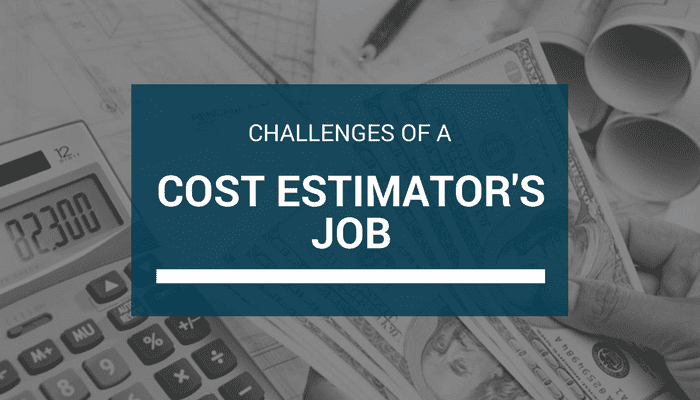If anyone asks, ‘What do you like the most about being a cost estimating professional?”,
An owner’s cost estimator might say ‘the cost estimator plays an important role in an owner’s budgeting efforts for different projects.’
A cost estimator working for a consulting firm might say ‘In addition to supporting an owner’s budgeting efforts, the cost estimator is able to provide cost solutions to their clients’.
Cost estimators working for contractors might say ‘they play a key role in winning bids for their contracting firm.’
A cost estimator’s job is always challenging
A conceptual cost estimator is required to prepare budget estimates with minimum details, a contractor’s estimator is challenged to know the pulse of the market and produce a competitive bid. Meeting hard deadlines, working on new types of projects, playing changed roles according to construction procurement methods, using technology for quantity take-offs and estimating, catching up with the advancements in BIM (Building Information Modeling) and the list goes on.
Meeting Deadlines
The first and foremost challenge is meeting deadlines. If you were with a contractor, needless to say, how much of a pressure it would be until the bid day. If you are with an owner, there is similar pressure to keep up the deadlines for your deliverables, testing your ability to operate under pressure and how you prioritize your work.
Working on multiple projects is another challenge. Either a contractor’s or owner’s estimator, there may be times you have to work on multiple projects with close deadlines. Remembering the project scope and the estimated line items and answering queries is what challenges you even more.
Quantification and Pricing Challenges on Different Types of Projects
New types of construction methods and project specifics could pose quantification and pricing challenges to an estimator. For example – with slurry walls, secant piles, and caissons, a ‘Top-down construction’ project may need a different pricing approach as it involves casting slabs first and mining earth instead of excavating and superstructure construction along with the basement structures!
Another project may necessitate quantifying rock excavation with widely varying contours from one end to the other end of a building and having a complex foundation design.
Yet another project might need preparation of independent estimates for complex change orders.
Changing Contract Procurement Methods
Advantages like Fast tracking of projects, distribution of risks, and sharing of cost savings with the contractors are causing owners to move away from the traditional Design-Bid-Build (DBB) to new project delivery models like Construction Manager at Risk (CMAR), Design-Build (DB), and Integrated Project Delivery (IPD). Due to this, traditional project planning, budgeting, management, and control systems are also changing.
Stakeholder relationships are modified, and there is a shift in the required estimating efforts during the pre-award and post-award stages of most projects. The same estimator may have to be a conceptual estimator as well as contractor’s estimator when stakeholder’s roles change. The changing nature of work poses challenges for both the Owner’s and the contractor’s estimators.
Evolving Technology
Technology – Although technology helps estimator for quick turnover of deliverables, it also involves learning and adapting. Traditional take-off methods have given way to on-screen quantity take-offs and with the advancement of BIM (Building Information Modeling), updating knowledge and skills to keep pace with technology has become a necessity.
Bringing Satisfaction and a Fulfilling Experience
With challenges, an estimator’s job also brings satisfaction and a fulfilling experience
- Estimator’s role is crucial to the success of an owner’s project, profit of a consulting or contracting firm.
- Estimators bring value to projects and make a meaningful contribution to project budgeting, cost planning, cost savings and cost control functions.
- Estimator plays an important role in the Value Engineering or Risk Management efforts of a project.
Larger Impact
When you think of the larger impact, like other construction professionals, estimators can always link their working experience to completed structures. When attending an event at a completed stadium or while waiting at the airport, you may recall your experience of working on those construction projects.
It makes you feel proud when you realize how projects that you worked on have made an impact (though indirectly) on people’s lives when you see people travel through an airport or train station, enjoy events at a stadium or theater, stay in a hotel or resort, work in an office building, and so forth.
US Bureau of Labor Statistics projects job growth of 11% through 2026 for estimators. With the looming trillion-dollar infrastructure and other projects, industry indicators like the Architectural Building Index (ABI) and other publications indicate growth in the immediate future, though it varies between sectors like residential, non-residential, and public infrastructure projects.
Along with the challenges of the profession and fulfilling experience, it is good to know that the industry outlook is positive for every ‘Money Man’ or ‘Woman’ crunching numbers and preparing cost estimates, either for the owner or contractor.
I would like to end my post with the same question to readers – “What Do You Like The Most About Being A Cost Estimating Professional?”
To learn more about the Cost Estimating profession, click here.
About the Author, Ramani Sundaram
 Ramani Sundaram, CCP, CEP, MRICS, PMP, is an experienced Project Management and Cost Professional with specialization in Cost Management and Cost Estimating. With an overall experience of 25+ years in the construction field, for the past 17 years, he has worked as ‘Senior Estimator’ and ‘Senior consultant’ in many cost consulting and construction management firms, performing cost estimating cost management and project control functions.
Ramani Sundaram, CCP, CEP, MRICS, PMP, is an experienced Project Management and Cost Professional with specialization in Cost Management and Cost Estimating. With an overall experience of 25+ years in the construction field, for the past 17 years, he has worked as ‘Senior Estimator’ and ‘Senior consultant’ in many cost consulting and construction management firms, performing cost estimating cost management and project control functions.
He has published an article in AACEI’s Cost Engineering Journal and has written many technical articles on the LinkedIn pulse and on other platforms. His prize-winning blog is posted on Project Control Academy’s website.
Ramani is a Board member and Certification Director in AACEI’s NJ section. He is a Certified Cost Professional (CCP), Certified Estimating Professional (CEP), Project Management Professional (PMP) and a Member of RICS (MRICS).
He can be reached at his LinkedIn Profile.


















